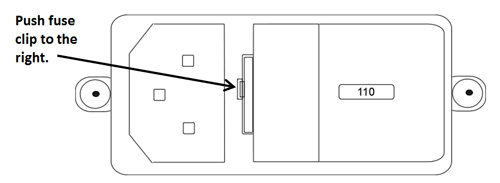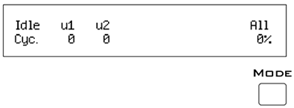RZ10x Lux Integrated Processor

RZ10x Overview
The RZ10x platform includes light driving/sensing capabilities for lock-in amplification fiber photometry setups. The RZ10x model has two banks of light driving/sensing ports for running multiple subjects or to add optogenetic stimulation, and includes fiber optic connections for integrated multi-channel neurophysiology.
The RZ10x Lux Integrated Processor has three 400 MHz Sharc digital signal processors (DSPs). It includes two banks of integrated Lux light drivers and photosensors. It is expandable to up to four DSPs.
Each Lux bank has 3 output drivers and 2 inputs. Each output port can have either a Lux LED, an M8 connector to drive an external LED, or a BNC connector to control a voltage signal. Each input port can have either a Lux PS1 or PS2 photosensor, a Lux PM1 power meter, or a BNC connector to measure a voltage input. The components are interchangeable by the user.
The RZ10x includes two additional analog input channels. The RZ10x fiber optic input port can acquire up to 32 channels of neurophysiological signals from a PZ5 or Subject Interface amplifier at up to ~50 kHz for real-time processing synchronized to your fiber photometry data and/or optogenetic stimulation.
The RZ10x features 24-bits of digital I/O (four bits are accessible on the front panel BNC connectors) and a legacy fiber optic port to acquire neurophysiological signals from a Medusa4Z, RA8GA, or RA16PA preamplifier.
This manual provides hardware information for the RZ10x. For a full application guide specific to fiber photometry using the RZ10x, see the Fiber Photometry User Guide.
Power and Communication
The RZ10x's Optibit optical interface connects to a PO5e, PO5c, or UZ3 computer interface for fast and reliable data transfer from the RZ10x to the PC. Connectors on the back panel are color coded for correct wiring.
The RZ10x's integrated power supply is shipped from TDT configured for the end user's regional voltage setting (110 V or 220 V). If you need to change the voltage setting:
-
Turn off the RZ10x
-
Use a small flathead screwdriver to gently push the clip along the left side of the fuse plate to the right to remove it.

-
Remove the white AC voltage selector and rotate it until the desired voltage is displayed, then reinsert it and put the fuse plate back on.
The RZ10x is UL compliant, see the RZ10x Operator's Manual for power and safety information.
Software Control
TDT's Synapse software controls the RZ10x and provides users a high level interface for device configuration.
RZ10x Features
DSP Status Lights

These LEDs report the status of the multiprocessor's individual DSPs and will be lit solid green when the corresponding DSP is installed and running. The corresponding LED will be lit dim green if the cycle usage on a DSP is 0%. If the demands on a DSP exceed 99% of its capacity on any given cycle, the corresponding LED will flash red (~1 time per second). For QZDSPs, the LED indicates levels for the core with the highest cycle usage.
Front Panel Display Screen

The front panel display screen reports detailed information about the status of the system. The top line reports the system mode, Run!, Idle, or Reset. The second line reports the user's choice of status indicators for each DSP followed by an aggregate value.
The user can cycle through the various status indicators using the Mode button to the bottom right of the display. Push and release the button to change the display or push and hold the button for one second then release to automatically cycle through each of the display options. The display screen may also report system status such as booting status (Reset).
Note
When burning new microcode or if the firmware on the RZ is blank, the display screen will report a cycle usage of 99% and the processor status lights will flash red.
Fiber Optic Port
The fiber optical port next to the Digital I/O connector can be used with a Subject Interface, PZ5 amplifier, or iCon Behavioral Controller for up to 128 channels of electrical stimulation, 32 channels or neurophysiological recording, or behavior control. It is labeled 'M' or 'SI'.
Note
RZ10x with serial number <2000 had a port labeled 'PZ' for PZ5 NeuroDigitizer support only.
Legacy Fiber Optic Port
The RZ10x has one Legacy fiber optic ports labeled Legacy Amp to acquire digitized signals from the Medusa4Z, RA16PA, or RA8GA. This port can read up to 16 channels at a maximum sampling rate of ~25 kHz.
Onboard Analog Inputs
The Onboard Lux I/O is the primary analog I/O on the RZ10x. However, the RZ10x has two extra channels of 16-bit PCM A/D input accessible through the BNCs marked 'ADC4' and 'ADC8'. See the Synapse Manual for information on using these inputs.
Digital I/O
The digital I/O ports include 24 bits of programmable I/O. The digital I/O is divided into three bytes (A, B, and C) as described in the chart below. All digital I/O lines are accessed via the 25-pin connector on the front of the RZ10x and bits 0 - 3 of byte C are available through BNC connectors on the front panel labeled Digital. See RZ10x Technical Specifications for the DB25 pinout.
The digital I/O is configured in the Synapse RZn Hal.
*Note: Byte C Bits 0 - 3 are available via front panel BNCs
The data direction for the Digital I/O is also configured in the Synapse RZn Hal.
The RZ digital I/O ports have different voltage outputs and logic thresholds depending on the type. Below is a table listing the different voltage outputs and thresholds for both types.
LED Indicators
The RZ10x has 16 LED indicators for the analog and digital I/O located directly below the display screen and DSP status LEDs.
Digital I/O
These LEDs indicate the state of the 8 bit-addressable I/O of byte C.
Analog I/O
These LEDs indicate the state of the four ADC and four DAC channels.
Note
ADC channel 3 and DAC channel 4 are used internally while the RZ10x is actively running, so the ADC3 and DAC4 LEDs will flash ~1 Hz during normal operation.
UDP Ethernet Interface
The RZ UDP Ethernet interface can transfer low bandwidth data directly to or from a PC. RZ devices equipped with a UDP interface have an additional Ethernet port and RS232 serial port located on the back panel. See RZ-UDP Communications Interface for more information.
Specialized DSP/Optical Interface Boards
The RZ standard DSP boards can be replaced with specialized DSP boards which include an optical interface for communication and control of RZ compatible devices, such as the Subject Interface and RS4 Data Streamer. RZ devices equipped with one or more specialized DSP boards include an optical port for each card. The ports are located on the back panel and labeled for easy identification.
Onboard Lux I/O
The RZ10x has two banks of integrated Lux components. Each Lux bank has three built-in current driver outputs for driving integrated LEDs directly, or external LEDs connected to an M8 cable. Each Lux bank also has two input slots for photosensors and/or power meters.
RZ10x Technical Specifications
Note
Specifications for amplifier A/D converters are found under the preamplifier's
technical specifications.
See the Lux hardware manual for
more information and technical specifications of the Lux pods.
BNC Channel Mapping
Please note channel numbering is printed on the face of the device to minimize mis-wiring.
DB25 Digital I/O Pinout

If using a PP24 Patch Panel, see PP24 to RZ10x Digital I/O.

